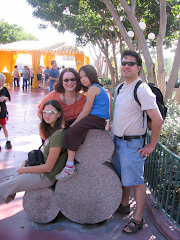
Paul Klee
Paul Klee is one of my favourite artists. He painted in a unique and personal style; no one else painted like he did. He used pastels, tempera, water color, and a combination of oil and water color, as well as different backgrounds. Klee valued the "primitive," and especially the art of children. He envied their freedom to create signs, and respected their innocence and directness.
Objectives
Students will create a 2 dimensional portrait.
Students will identify and use geometric shapes.
Students will identify the work of artist Paul Klee.
Vocabulary
color, resist, geometric shapes.
Materials: shape tracers including large circle, rectangle, square, triangle, oil pastels, 11"x17" white paper, orange tempera paint thinned with water and wide flat brushes.
Procedure
Ask students to recall having had their school picture taken. Tell them that was a photograph portrait but there are also portraits which are painted. Show the print of Senecio (Head of Man) by Paul Klee. Have students draw a portrait of someone in the class or themselves using geometric shapes that they have outlined or have drawn themselves. Have them press hard as they color in the shapes with the oil pastels. Paint the drawing by dipping the brush in the wash and moving it from one side to the other across the top. Dip again, slightly overlap and paint a second row. Continue to the bottom. If the layer of paint is too thick you can blot with paper towels to allow the pastels to show through. Allow to dry.
Assessment
- uses geometric shapes to create a portrait
- uses materials appropriately
- participates in discussion
Integration of Technology
Students will use an illustrator computer program to create another Paul Klee type portrait using the same basic principles. For example, they will put geometric shapes together to create a portrait and they will apply an opaque mask or another effect to entire portrait to create the illusion of paint.
Source
Modern Art-Elementary Lesson Plans
Written by Tabitha Ward
http://members.aol.com/TWard64340/modern.htm
GLE-General Learner Expectations
Reflection, depiction, composition and expression.
A Learning Experience
-a knowledge of the vocabulary of basic art terms and expressions appropriate to the student’s level of development
-skills and techniques necessary for meaningful self-expression by the child
-an understanding of art media, materials and processes and their appropriate use
-an understanding of the expressive content inherent in visual forms.
In Depiction, the basic skills of image making are developed using one of more of the three reflective areas as referents. These skills are developed according to forms and their proportions, actions and viewpoints and the qualities and details of those forms.
SLE’s Specific Learner Expectations
Depiction
Component 4-Main Forms and Proportions: Students will perfect forms and develop more realistic treatments.
Concepts A, B, and C
A-Shapes can suggest movement or stability
B-Many shapes are symmetrical
C-Images can be portrayed in varying degrees of realism.
ICT Relevance-Processes for Productivity
P3-Students will communicate through multimedia
>create a multimedia presentation, incorporating such features as visual images (clip art, video clips), sounds (live recordings, sound clips) and animated images, appropriate to a variety of audiences and purposes.
>Access available databases to support communication.
Why use technology?-the fine arts curriculum is so outdated that using any type of technology improves the lesson because it adds the current world to the old world. It puts art in a more up-to-date context. With this particular lesson plan the children will learn the art historical way to create a Paul Klee-type portrait and then they will integrate illustrator-type technology to create another portrait. I hope that it will give the students an appreciation for both types of art making.
